Ten reasons Google+ deserves to beat Facebook
Posted by Alex on 10 Jul, 2011 in Technology & Society | 7 comments
Last week Google launched Google+, a new social platform which many are comparing to Facebook. It is quite different from Facebook or Twitter, though it is clearly inspired by both. If it is to gain broad acceptance and not fade away like Orkut, Buzz and Wave–Google’s past attempts to build a social network–then it needs to be more than just “good enough”. It has to wow its critics. The good news is, Google+ seems to be doing just that. Here’s ten reasons why it deserves success:
1. An intuitive, well-designed interface
Until last week, Facebook was the most effective interface on the web for online socializing. Today, that is no longer true. Google have clearly looked at Facebook’s strengths and weaknesses, and been careful to not only emulate its strengths, but tackle every single shortcoming and add new capabilities.
The complexities of interacting with your various friend groups are reduced to a simple set of features:
- Stream (status updates and shared items)
- “Circles” – groups of friends that you share stream items with or use to filter the stream
- Huddles (group instant messaging – Android only for now)
- Sparks (subject-related news, to “spark” conversation), and
- Hangouts (a video chat room for up to 10 people)
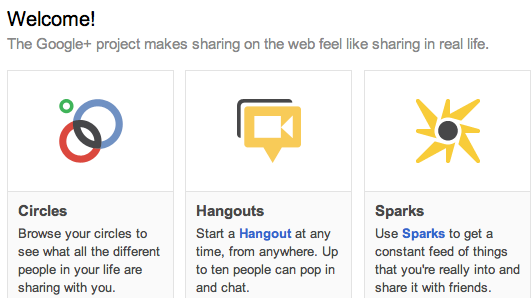 You can read more about these concepts on Google’s blog. But there’s a lot of hidden power under the covers – checkins, photo tagging and mobile uploads are just some of the other features that you’ll also find if you dig deeper.. It’s amazing how simple the interface is compared to Facebook. Facebook has probably three times as many pages and four times the number of configuration settings to achieve the same results.
You can read more about these concepts on Google’s blog. But there’s a lot of hidden power under the covers – checkins, photo tagging and mobile uploads are just some of the other features that you’ll also find if you dig deeper.. It’s amazing how simple the interface is compared to Facebook. Facebook has probably three times as many pages and four times the number of configuration settings to achieve the same results.
2. Making configuration fun
One of Facebook’s failings is that it encourages you to treat every friend the same – from your best friend to that guy you once met at a party. It does support groups, but they are awkward to use and configure, so people rarely use them, and so updates can be seen by everyone.
Google+ recognizes that our lives consist of different social “circles” – and provides easy-to-use controls that make friend management not just simple but fun. Add someone to a group, the circle spins as their photo pops into place. If you remove a group, the circle rolls off the side of the screen playfully.
The privacy management and feedback interfaces are equally innovative. If you want to control what people can see, just enter visibility mode, and click the part of the profile you want to change. To give feedback on the site, enter feedback mode then highlight part of the screen or black out personal information. With these designs, Google clearly released that configuration is an necessary evil for effective social networking, but that it needn’t be a chore – it can be part of the social experience.
3. Asymmetric
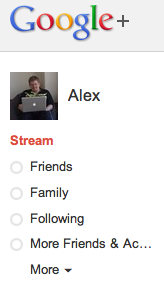 In our lives, few friendships are completely symmetrical. Often one person is more interested than the other. That’s why in Google+, the circles of friends you create are entirely yours. You don’t need someone’s permission to add them to a group – it’s just for you, and you can organize people in a way that makes most sense to you. This also means that you can “follow” people, Twitter-style, without requiring anything from them in return, and record your friend groups as you think of them, without needing friends to “add” you.
In our lives, few friendships are completely symmetrical. Often one person is more interested than the other. That’s why in Google+, the circles of friends you create are entirely yours. You don’t need someone’s permission to add them to a group – it’s just for you, and you can organize people in a way that makes most sense to you. This also means that you can “follow” people, Twitter-style, without requiring anything from them in return, and record your friend groups as you think of them, without needing friends to “add” you.
The other great thing about Circles in Google+ is you can use them two ways. Firstly, as a group to communicate with, and secondly, as a filter to control whose updates you read. You can even create different groups for each purpose, which may or may not overlap. In this way, you can choose with a very fine degree of control, what information you consume, and who your audience will be for a specific post – something that is not as easy on Facebook.
4. Inclusive
One of the things I’ve found most frustrating about Facebook is this:
I can’t fill in my wife’s name, because as far as Facebook is concerned, she doesn’t exist. Facebook can never be a true social network, because some people don’t want to join Facebook.
Thankfully, Google+ is far more inclusive. I can add anyone in my life into my Google+ Circles using just their email address. (Do you know anyone without an email address these days?). Even if they never sign up for Google+, I can still share with everyone I want to, from one place. Messages will be delivered to their inbox:
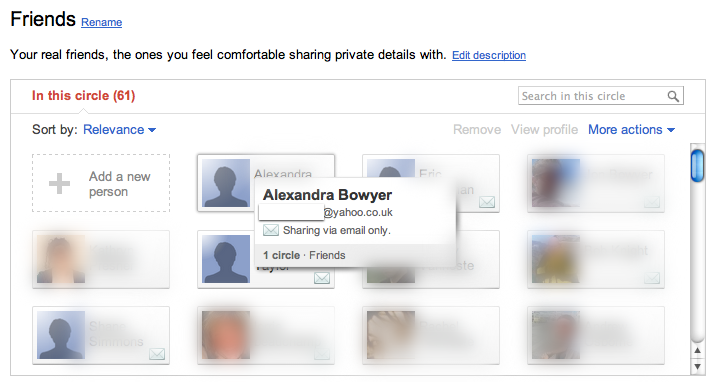 (Side-note: My wife and I just separated; but as this is a great way to illustrate the point, I am still using the example.)
(Side-note: My wife and I just separated; but as this is a great way to illustrate the point, I am still using the example.)
This wider sharing ability introduces a new etiquette – We’ll need to ask people who chose not to join you on Facebook whether their choice was because they didn’t like Facebook, or because they are not interested in social updates in general – after all they may not want to receive your updates. But at least now you have the choice to keep them updated without having to convince them to join. I think it’s helpful to consider Circles as more like groups in your email address book than Facebook groups.
In this way Google is the first social network to realize that our social lives extend beyond the bounds of any one social product, and leaves our friends free to make their own social network choices without excluding others.
5. Sensible defaults
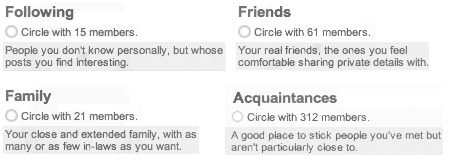 When you sign up for a new social network, you don’t want to start from a blank page. From the start, Google+ presents you with a list of contacts from Gmail based on who you email the most (you can also import from Yahoo or Hotmail). You can then drag and drop these contacts into different circles. Four default circles—Friends, Family, Following and Acquaintances—are created for you. You can add additional groups or tweak the existing ones, but in the main, no thought is required. Facebook added group support, but people had to go out of their way to create such groupings. Few people bothered, resulting in everyone having one giant “friendblob”.
When you sign up for a new social network, you don’t want to start from a blank page. From the start, Google+ presents you with a list of contacts from Gmail based on who you email the most (you can also import from Yahoo or Hotmail). You can then drag and drop these contacts into different circles. Four default circles—Friends, Family, Following and Acquaintances—are created for you. You can add additional groups or tweak the existing ones, but in the main, no thought is required. Facebook added group support, but people had to go out of their way to create such groupings. Few people bothered, resulting in everyone having one giant “friendblob”.
Google+ doesn’t just offer features, it guides you through the best way to use them, making it easy to get in the habit of using these new features.
6. Fine-grained, transparent privacy control
Through its “circles”, Google+ makes it incredibly easy to share with only the people you want to and no-one else:
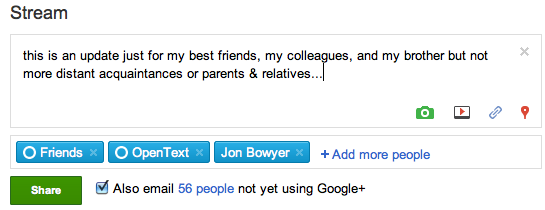 You can select specific groups, or individuals, to share with, and omit the ones you don’t want to see it. This is already hugely more usable than Facebook’s “Limit visibility” feature.
You can select specific groups, or individuals, to share with, and omit the ones you don’t want to see it. This is already hugely more usable than Facebook’s “Limit visibility” feature.
What’s more, the interface makes it very clear what is visible to whom. If you’ve ever tried to restrict a photo album or post on Facebook, you’ll know it’s very easy to have some heart-in-your-throat moments when you see a “private” post appearing on your Wall with all your other posts, apparently visible to all. On Facebook a public and a private post look the same. You have to trust that the system is only showing that post to you and the people you selected, and not to everyone. It’s unnerving at best. Google+, on the other hand, is absolutely transparent and clearly displays the audience next to every post:
This gives you confidence in the system. You can even click the word “Limited” and see a popup of exactly who a post is shared with. There is never any doubt that maybe someone can see something you don’t want them to. Google finally solved online privacy in a way that is intuitive and obvious.
7. An open garden with no walls
Facebook is the most famous example of the “walled garden” approach to social networking – you need to be inside Facebook to participate. But now people can visit your Google+ profile even as a non-member, and see your public updates.
Friends (in the real life sense) can now receive social updates you choose to send them, all without signing up. In future, Google may even allow people to comment or reply using something other than a Google+ address. Even without that, it’s clear that Google+ is making every effort to allow you to use Google+ to reflect your real social life, not just the subset who are willing to join Facebook.
And it’s not just outbound communication that’s unconstrained, but Google+ is open to incoming readers too. When you see the word “Public” in Google+, it really means public – like with Twitter, anyone on the web can see it. Whereas on Facebook a “public post” is only visible within Facebook.
This choice of public or restricted is not to be underestimated. It means Google+ gives us the best of both worlds, something neither Twitter, nor Facebook, nor even blogs, can offer – the ability to use one platform to both communicate publicly and limit readership to a select group – even one person – who need not even sign up, remember. Each post can be as public or private as you feel is most appropriate. It’s not just the first social network to solve this problem, but the first online publishing platform to solve it.
8. Data liberation
As we store more and more information online, it’s vital that we keep control of our data and are free to move it wherever and whenever we like. This means not just giving us download and export options, but ensuring that the exported data is in a usable format. An action group within Google, calling themselves the Data Liberation Front, have ensured that Google+ is the first Google product to truly embrace this way of thinking. On your first visit to Google+ preferences, you’ll see a whole section dedicated to “data liberation”, not just of Google+ data but other Google services too:
What’s noticeable here is that the downloads are available instantly, in useful formats – Contacts come as vCard files, profile data as JSON, etc. This is all done using a new Google service called Google Takeout.
On Facebook, when they finally did release the ability to download your data, the service was somewhat limited; you have to wait until they email you the data, and when you do get it, it’s incomplete, and provided as styled HTML, not useful for much besides viewing in a web browser.
As if to emphasize the difference even more, Facebook have now locked down the ability to export friends’ email addresses – presumably as a direct measure to stop you importing them to Google+ (workarounds are available). I know which company’s approach I prefer.
9. Noncommercial (for now)
One thing that you notice about Google+ is that there is more white empty space. At first you think it’s just Google’s minimalist style. But what’s really exciting is when you realize the real reason–there are no adverts, and even better, your stream consists solely of updates from real people. On Facebook, “like” a TV show and your stream begins to fill up with promotional trailers and fan feedback campaigns from that show. On Twitter , you already see content that is not really trending, but a paid promotion by companies.
Right now, Google+ is a quiet, relaxing place to hang out and focus on your friendships without feeling like people are selling to you.
This won’t last for ever, as Google looks to monetize the service, and media companies figure out how to get in on the act and win our eyeballs in yet another space. Nothing comes for free – and as we all know, the price of free social media is having to look at things you don’t want sometimes.
Also I’m hopeful, based on my 6+ years experience with Gmail, that when advertising does come to Google+, it will be done discreetly, and with consideration to users’ hostility towards advertising in a social space.
10. Positioning
Finally, the other reason that Google+ deserves to succeed is the way it has been positioned. The name “Google+” is very clever. Unlike any other Google service, it doesn’t have a unique name like Buzz or Wave. It’s just an extension of “Google” – now an everyday term with a huge amount of positive brand image and recogition behind it. This lack of distinct naming will make it much harder for any bad press or bad feeling to stick to Google+.
It’s not just the naming, though, Google+ is not so much a social network, as a weaving together of existing Google products. For example – what was your Google Profile is now your Google+ profile page. Once you are on Google+, you have a common Google/Google+ toolbar throughout all Google products, tying together Google+ with Google email, calendar, Google Docs, RSS reader, search and more:
This has huge potential. In time, this will become the default Google toolbar, thus exposing all Google users to the power of Google+ social networking. The bar not only provides short links between services, but highlights social notifications (replies to your posts, for example) much like Facebook’s notifications menu. There’s even a little “share” box for quickly sharing something without going to Google+ homepage.
What this all means is that no matter how few people adopt Google+, it’s here to stay. It will not and can not die off like Buzz or Wave. It’s a tightly integrated part of the Google experience. Clearly, there are downsides to not being able to escape it – but also it provides a huge strength for Google+ in its battle against Facebook.
Does Google+ really stand a chance of dislodging Facebook?
Some people think so. I am not so sure, Facebook has such a huge monopoly. And what’s more, they own your entire friend graph. But with all these carefully designed features, not to mention innovative new ways to socialize like video hangouts, Google+ is going to do one thing – fragment the social landscape that until now has been 100% owned by Facebook (for example like this).
This can only be a good thing, because it may force Facebook to work together with other social networks to develop a standard for social networking so that people can communicate across different providers (something we take for granted with email and phone companies). Perhaps, like the early walled email provided by AOL and Compuserve, Facebook’s days as a closed social network may be numbered, even if it won’t be toppled as the dominant social network yet.
Some are even saying that Google’s real goal wasn’t to beat Facebook at all, but to force them to open up their walled garden. Having said that, there are rumours Google+ already has 4.5 million users. So anything is possible.
What do you think? Add your comments below…




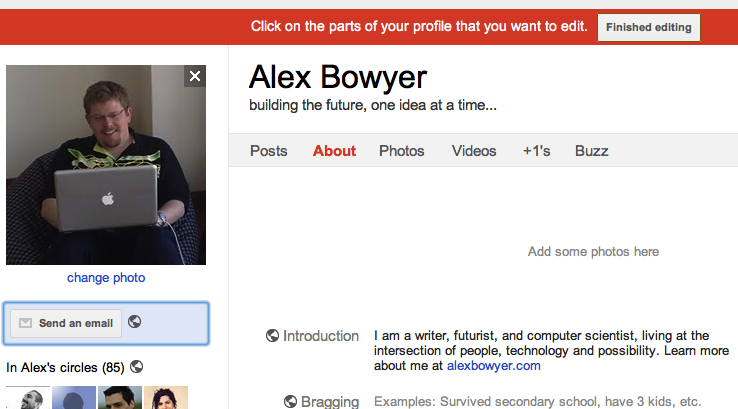

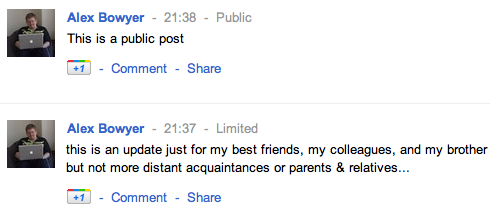

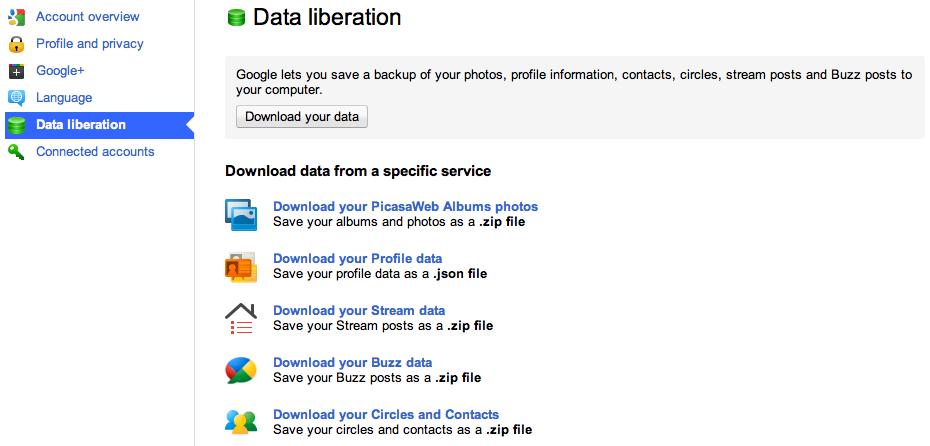
I can’t really argue with most of your post, as it’s pretty well thought out and structured. I have to say though that I really don’t see it as much of a leap from Facebook. Yes the interface is a little more shiny, and indeed a little better thought out, a definite benefit of copying someone else’s design after the event. Can’t say I’ve been too impressed with my Google+ experience so far. It feels like Facebook+. It has its own problems. Try following a conversation that has become realtime! It has copied Facebook problems. Why can’t I dislike (-1) . Why can’t I set a single picture to a different privacy level. Why can’t I choose which types of posts I want to filter out? And following some of the high profile adopters it’s obvious that there are other issues – blocking people for example. That said, I’m sure the site will develop and resolves it’s early issues.
My biggest problem with Google+ is that it is Google. I trust them far less than I trust the Walled Garden facebook. Google’s whole business model is built around mining other people’s data to make money. It is in their interest for your data to be more public. Their email sharing model smells of spam to me.
I do however welcome the introduction of Google+, I hope that the system develops sufficiently to either make Facebook better or to move towards and open full sized inclusive social network where we don’t need to care who your social network provider (SNP) is. If the later is not possible, I hope that facebook wins, because I don’t think the masses are ready for a migration from one system to another, and a fractured social network helps nobody.
Sure, it’s easy to come up with a better design when you aren’t starting from scratch. But I think Google+’s biggest innovation is that it shifts the balance of power more to the user. Dislike, picture privacy, blocking, they’re all small issues that as you say will be fixed.
Very interesting that you trust Facebook more than Google. I think Facebook have had far more privacy breaches than Google (check out some of the links in this article: http://www.human20.com/facebook-is-an-abusive-relationship/)
You’re right that it will make Facebook better that Google+ exists.
I agree the masses are not ready for migration, but I hope that if even 5% of people migrate it will be enough to force the creation of social network protocols (perhaps they could even use the Wave protocol which is already open). I love your acronym of SNP – will probably be as common a term as ISP or email provider.
I think that Google+ could also take a a few chunks out of LinkedIn. The easy segregation of content/post types via Circles could make it very easy to keep work and social apart without having to switch between two different sites.
Great idea. A number of people are already looking at ways to use Google+ for document creation, gradually opening things up over time… (like this)
For me, Google+ just seems a lot of hassle. The navigation isn’t as clean and simple as Facebook, and there’s no obvious attempt to sort out the issue of contacts with multiple email addresses.
But the real problem is that, software developers aside, nobody I know is using it.
I might go back to it if it catches on significantly among ordinary people, but I’m really not sure it will. Because while I’m sure Google+ can do more than Facebook, I’m already *not* using half the functionality that Facebook offers. It does what I want and I simply can’t be bothered to dig any deeper. If any of Google+’s features become popular, then Facebook can always add their own version of them.
I’m just an ordinary, non-techy person but I suspect a lot of people like me already have one or two social networks in their lives. And, if they’re like me, they probably don’t need another.
You are right, mainstream adoption will be key.
I disagree that the navigation isn’t as simple as Facebook. On Facebook, try and filter your stream by just a certain group. Now try the same operation on Google+. It’s way simpler (in fact I am not even 100% sure it’s possible on Facebook).
Another example – try and share something with two groups and a couple of individuals on facebook. Now try it on Google+. Again, fewer clicks, way simpler.
I know, but that’s not how I use Facebook. Not disagreeing with the technical / feature-set points you raise in your article, I’m just saying that these things may not be enough to win “civilians” over to G+.
It’s kind of ironic that Google (who achieved search engine dominance with the cleanest, simplest web page at a time when everyone else was bombarding their audience with portal content and banner ads) are trying to out-feature their rivals.